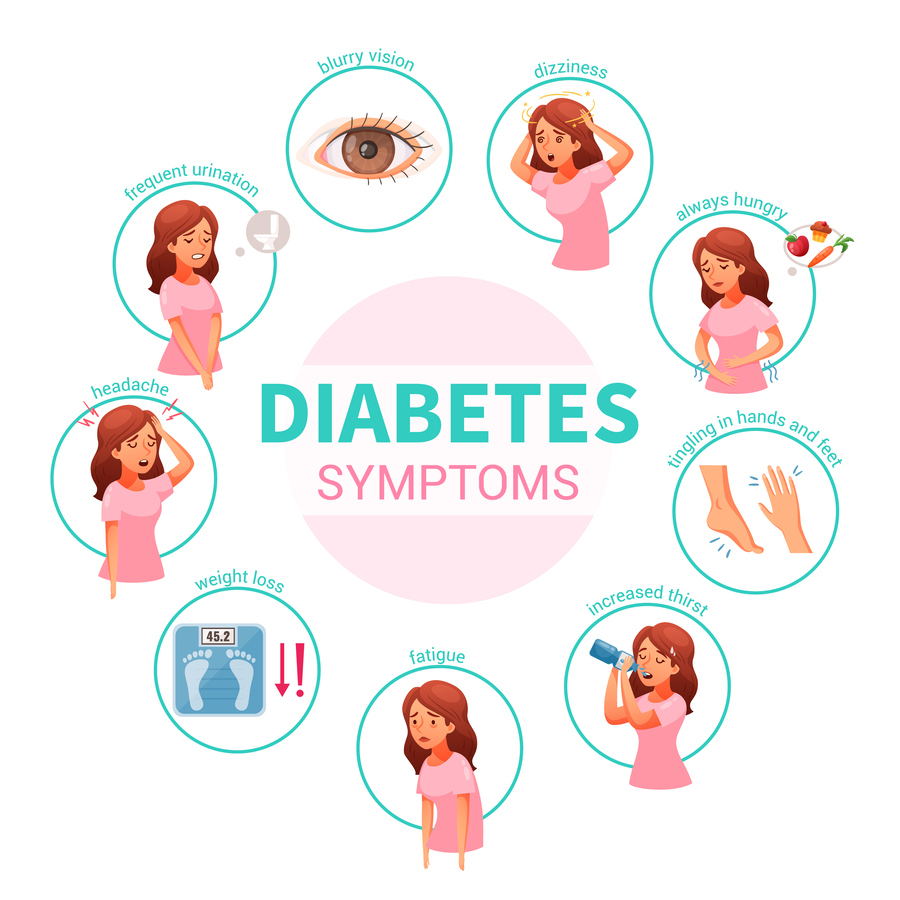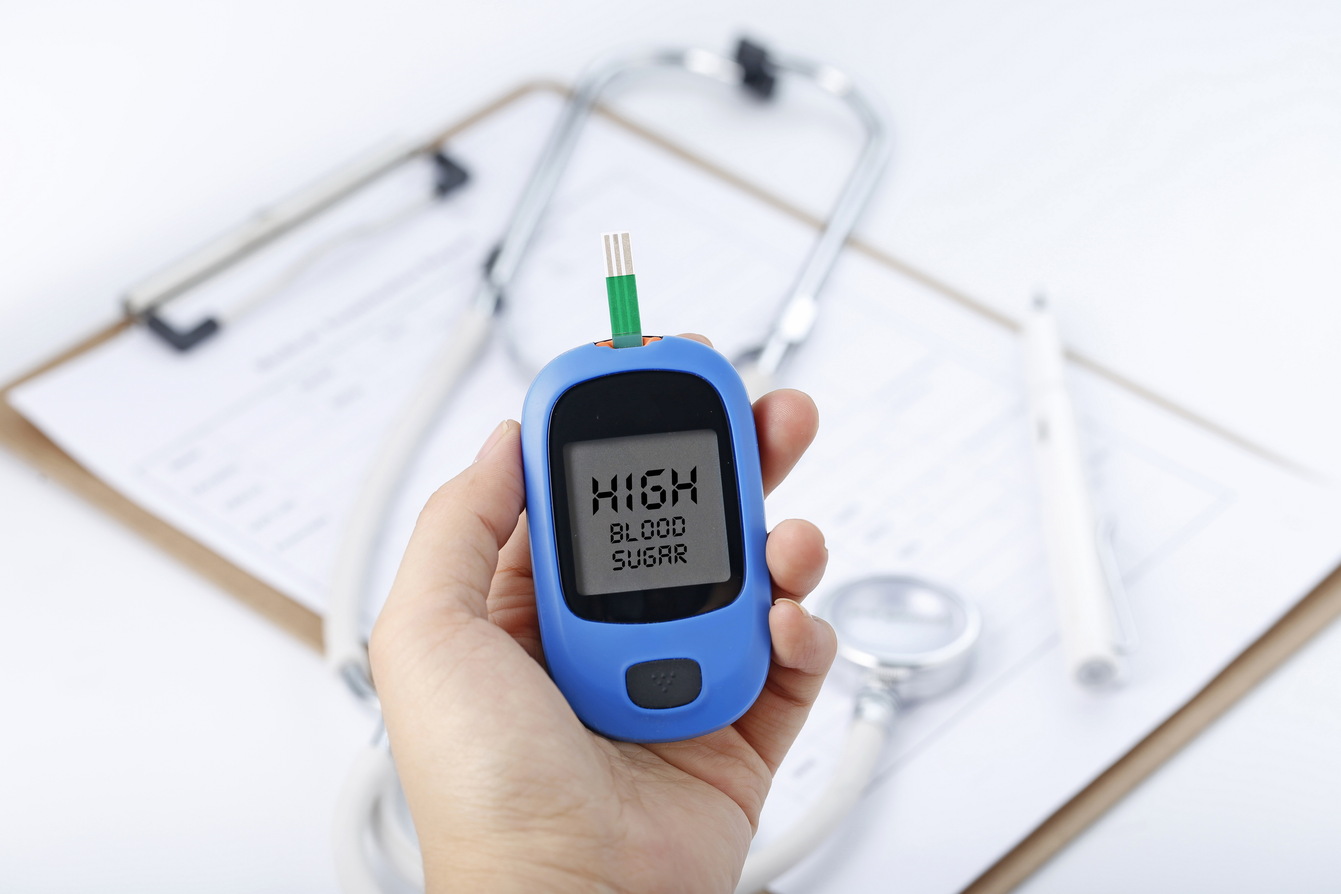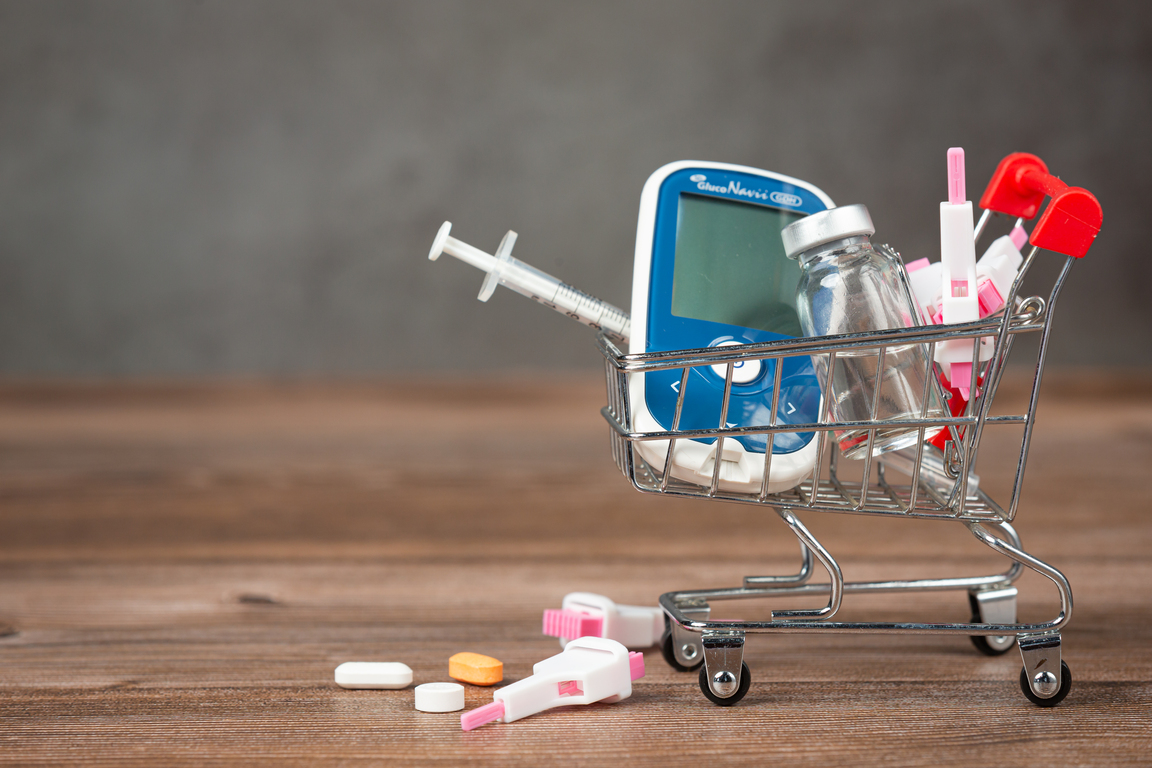Let’s talk about type 2 diabetes. It’s a common health condition, affecting millions globally, and sometimes it even shows up earlier in life these days. While it sounds serious (and it can be), the good news is, you can take control!
Why is Early Diagnosis Important?
Catching type 2 diabetes early is key. It helps prevent complications down the road, like heart disease or even some cancers. Think of it as catching a leak in your house before it becomes a major flood.
Facing the Challenge: It’s Not About Restriction, It’s About Empowerment
Sure, hearing you have diabetes might be a bit overwhelming. Maybe you’re picturing strict diets and a total lifestyle overhaul. But here’s the thing: managing type 2 diabetes is about learning new habits, not deprivation.
Unleash Your Inner Nutrition Superhero
Understanding how your body uses insulin and recognizing the signs of diabetes equips you to make informed food choices. It’s like becoming a superhero for your own health! Imagine, choosing delicious and nutritious foods that keep you feeling great.
Can You Actually Reverse It?
There’s exciting research suggesting that significant lifestyle changes, especially focusing on diet, might even reverse type 2 diabetes in some cases. Think ketogenic diet (high-fat, low-carb) or even bariatric surgery (weight loss surgery) as potential tools in your reversal journey. But remember, these require doctor supervision.
The Key to Success: Partnering with Your Doctor
The most important step? Talking to your doctor. They’ll be your partner in creating a personalized plan to manage your diabetes effectively. With knowledge and the right support system, you can take charge of your health and live a full, vibrant life
In this article, delve into these insights and more. Take a moment to explore and empower yourself to take control of type 2 diabetes.
Symptoms and Early Signs of Type 2 Diabetes
Type 2 diabetes can be sneaky at first, sometimes showing no symptoms in the early stages. But that doesn’t mean you’re in the clear. Here are some red flags to watch out for:
- Bathroom Breaks on Repeat: Going to the bathroom much more often than usual, especially at night, could be a sign.
- Unquenchable Thirst: Feeling constantly thirsty, even after drinking fluids, is a potential warning.
- Weight Loss Without Trying: Losing weight unexpectedly, especially when you haven’t changed your diet or exercise routine, can be a symptom.
- Blurry Vision: Having trouble seeing clearly, like things appear foggy or blurry, could be related to diabetes.
- Dark, Velvety Skin Patches: Developing patches of dark, thick skin on the neck or armpits can be a sign of type 2 diabetes.
- Extreme Fatigue: Feeling constantly tired or run down, even after a good night’s sleep, can be a symptom.
- Slow Healing Cuts and Scrapes: noticing nicks or wounds taking much longer than usual to heal could be a warning.
What to Do if You See These Signs
If you experience one or more of these symptoms, especially if you have risk factors for type 2 diabetes, don’t wait! Talk to your doctor right away. Early diagnosis and treatment can make a big difference in managing your health.

Reason behind Type 2 Diabetes
The precise cause of type 2 diabetes remains elusive to researchers, although they believe that multiple factors contribute to its development. These factors are linked with genetic predisposition and lifestyle choices.
Central to the onset of type 2 diabetes is insulin resistance, a condition that often precedes an official diagnosis. Individuals may first receive a diagnosis of prediabetes before progressing to type 2 diabetes.
1. Ability to resist Insulin.
In a healthy body, insulin acts like a key, unlocking the doors of your cells and allowing glucose (sugar) to enter for energy. But in type 2 diabetes, things get a little jammed.
This is where insulin resistance comes in. It’s when your cells become stubborn and don’t respond as well to insulin’s key. As a result, glucose struggles to enter the cells, leading to a backup in the bloodstream – high blood sugar (hyperglycemia).
The Body’s Response:
Our resourceful body tries to fix this by producing more insulin, hoping to force the doors open. This can lead to high insulin levels in the blood (hyperinsulinemia).
The Long-Term Impact:
Unfortunately, this extra insulin production can only go so far. Over time, chronic insulin resistance can worsen, making it even harder for glucose to enter your cells. This is a key factor in the development of type 2 diabetes.
The Silent Culprit:
The tricky part? Insulin resistance often develops gradually, and symptoms might not be readily apparent. That’s why early diagnosis is crucial for managing blood sugar levels and preventing complications.
2. Prediabetes
Prediabetes can be rewritten as “pre-diabetic condition” or “early stage of diabetes.”
The pancreas may initially cope with the increased demand for insulin caused by insulin resistance, but it ultimately experiences excessive strain.
Nevertheless, production capability is limited and over time elevated blood sugar levels may result in prediabetes which can lead to type 2 diabetes.
A prediabetes diagnosis does not automatically result in type 2 diabetes as early detection and lifestyle modifications can impede the advance of the condition.
The Centers for Disease Control and Prevention reports that Prediabetes and Type 2 Diabetes are widespread globally, impacting more than hundred million Americans. Nevertheless, scientists remain unclear about the particular genetic aspects causing insulin resistance.
Risk Factors of Type 2 Diabetes

A variety of factors contribute to the development of type 2 diabetes, and simply targeting one factor, such as decreasing sugar consumption or upping exercise, is not adequate for prevention.
Below are some key factors that can impact your risk of type 2 diabetes:
1. Obesity or being overweight substantially elevates the risk of developing type 2 diabetes, which can be evaluated through the body mass index (BMI)
2. Overconsumption of calorie-dense processed foods and sugary drinks, coupled with a deficiency of nutrient-rich whole foods, increases the likelihood of developing type 2 diabetes. It is advisable to limit intake of white bread, chips, cookies, cake, soda, and fruit juice, and instead focus on incorporating fruits, vegetables, whole grains, water, and tea into your diet to decrease the risk.
3. The adoption of a sedentary lifestyle, where individuals spend excessive time watching TV programs, using cellphones, and surfing the internet, or sitting without engaging in enough physical activity, can significantly heighten the risk of obesity, type 2 diabetes, and various other health issues.
4. Limited Physical Activity , Regularly engaging in physical exercises, such as cardio and strength training, is vital for increasing lean muscle mass. This is essential for protecting against insulin resistance and type 2 diabetes.
5. Disruptions in sleep patterns can throw off the body’s ability to manage insulin and blood sugar, ultimately heightening the risk of type 2 diabetes.
6. Individuals with PCOS, a hormonal disorder called Polycystic Ovarian Syndrome, are at an elevated risk of developing type 2 diabetes due to common factors such as insulin resistance and obesity.
7. As individuals get older, the chances of developing type 2 diabetes generally increase. However, there has been a troubling increase in the occurrence of this condition among children and adolescents in recent years.
Awareness of these factors can enable individuals to take proactive measures in lowering their risk of developing type 2 diabetes and enhancing their overall health.
Is Type 2 Diabetes Caused by Genetics?
Your genetic makeup can impact your chances of developing type 2 diabetes, along with your diet and lifestyle. Studies on twins have revealed that identical twins are more likely to both have diabetes than fraternal twins. Moreover, having a relative with diabetes can greatly increase your own risk of getting the condition.
Your ethnic background might affect your vulnerability to type 2 diabetes, as research indicates. The data provided in this paper suggests that African Americans, Latino Americans, and specific Native American communities are at a higher risk of developing type 2 diabetes compared to white individuals.
Diagnosing Type 2 Diabetes
Early detection is key to effectively managing type 2 diabetes. Certain individuals should prioritize getting screened for the condition ,these include those who are overweight (with a BMI of 25 or higher) and aged 45 or older. Additionally, people with a family history of diabetes or experiencing symptoms such as frequent urination, unusual thirst, or unexplained weight loss should also consider undergoing screening.
There are two main tests used for screening type 2 diabetes:
Glycated hemoglobin (A1C) test : Discover the A1C Test, a remarkable blood test that offers insights into your average blood sugar control throughout the last 2-3 months. The results are conveniently grouped into three categories: normal (below 5.7%), prediabetes (5.7% to 6.4%), or diabetes (6.5% or higher after two separate tests). By understanding your A1C levels, you can gain valuable knowledge about your overall blood sugar health.
Fasting glucose test: Before the Fasting Blood Sugar Test, it’s important to fast for 8 hours. The results will show if your levels are normal (less than 100 mg/dL), indicate prediabetes (100 to 125 mg/dL), or confirm diabetes (126 mg/dL or higher on two separate tests).
Your physician may employ other tests like an oral glucose tolerance or random blood sugar test in certain cases. Detecting type 2 diabetes early and receiving timely treatment is crucial to manage it efficiently. Consult with your doctor about potential risk factors for determining if screening is necessary, and make sure you stay proactive by prioritizing your health!
Outlook for Type 2 Diabetes
When it comes to Type 2 Diabetes, the outlook can vary depending on several factors. The duration and severity of the condition, along with genetic factors, all come into play. If diabetes is not well managed over a prolonged period, there is an increased risk of complications like heart disease and neuropathy.
It is a sad reality that individuals living with diabetes often experience shorter life expectancies in comparison to those who do not have this condition. However, it is important to bear in mind that much of the research conducted in the past was done before the advent of advanced treatments.
Even with these obstacles, there is still room for hope. You are not limited by numbers. Detecting the issue early can lead to better control and lower chances of problems arising.
Embrace a proactive approach to managing your diabetes and witness a remarkable improvement in your quality of life. By diligently monitoring your blood sugar, following a well-balanced diet, engaging in regular exercise, taking your medications as prescribed, and keeping your weight in check, you’ll discover a newfound sense of well-being.
How Long Type 2 Diabetes Bother You?
Type 2 diabetes management involves changes in diet, lifestyle, and medication, but it’s crucial to understand that insulin resistance cannot be cured permanently. A significant reduction in body weight, around 5 to 7 percent, can be a game-changer in lowering blood sugar levels.
Following a balanced diet, regular exercise plan, and weight loss journey can help you better manage type 2 diabetes. As time goes by, additional treatments may be necessary, and if your blood sugar levels are not well-controlled, insulin therapy may be required for improved management.
High and Low Blood Sugar in Type 2 Diabetes
Type 2 diabetes can lead to fluctuations in blood sugar levels, causing both hyperglycemia and hypoglycemia. It is important for individuals to be able to recognize the signs, understand the underlying factors, and have knowledge about available treatment options. By doing so, they can effectively manage these episodes and maintain their blood sugar levels within a healthy range.
Blood Sugar Levels: Understanding the Difference
- Normal Blood Sugar: For healthy people, blood sugar stays between 70 and 100 mg/dL before meals. After eating, it rises slightly to around 120-130 mg/dL and rarely goes above 140 mg/dL.
- Blood Sugar in Type 2 Diabetes: In people with type 2 diabetes, blood sugar can jump much higher, reaching 200, 300, or even 400 mg/dL or more if not managed.
- The Importance of Monitoring: High blood sugar often doesn’t cause obvious symptoms. That’s why regular monitoring, as recommended by your doctor, is key.
- Warning Signs of High Blood Sugar (Hyperglycemia): Look out for increased urination, excessive thirst, fatigue, blurry vision, and persistent hunger even after meals. These could be signs of high blood sugar.
- Working with Your Doctor: If you have type 2 diabetes, creating a treatment plan with your doctor is essential. This plan will help you keep your blood sugar within a healthy range.
Blood Sugar Swings: What to Watch Out For
Even with treatment, your blood sugar levels can fluctuate. Here are some things that can cause these ups and downs:
- Med Mix-Ups: Missing your medication or taking the wrong dose can throw off your blood sugar control.
- Carb Overload: Eating too much, especially sugary or starchy foods, can lead to spikes.
- Sleepless Nights: Not getting enough sleep disrupts hormones that manage blood sugar.
- Stress Bouts: Emotional stress can trigger the release of hormones that hike up blood sugar.
- Exercise Extremes: While exercise is great, very intense activity can temporarily raise blood sugar.
- Feeling Under the Weather: Illness or infection can make it harder for your body to regulate blood sugar.
Type 2 Diabetes: Low Blood Sugar is a Possibility
While type 1 diabetes is more commonly associated with low blood sugar (hypoglycemia), it can also affect people with type 2 diabetes, especially those using insulin.
The Target Zone: In diabetes management, a blood sugar level below 70 mg/dL is typically considered low. It’s important to remember this is a general guideline, and your doctor might set a specific target range for you.
Understanding the Causes: There are a few reasons why low blood sugar can occur:
- Burning the Reserves Too Fast: Our bodies use glucose for energy. If you use it up quickly through exercise without proper fueling beforehand, or if you don’t eat enough overall, your blood sugar can drop.
- Glucose Release Lag: Sometimes, the breakdown of carbohydrates for glucose absorption takes longer than expected.
- Insulin Imbalance: Insulin helps your body use glucose. If there’s an imbalance, with too much insulin in your system compared to available glucose (due to medication or missed meals), it can lead to a blood sugar dip.
Warning Signs of Low Blood Sugar: Low blood sugar symptoms can vary, but here are some common ones to watch out for:
- Sudden, Intense Hunger: This is often one of the first signs.
- Feeling Dizzy or Weak: You might feel lightheaded or have trouble concentrating.
- Sweating: You might break out in a cold sweat, even if you’re not hot.
- Shaking or Tremors: You might experience trembling or shaking in your hands or body.
- Anxiety or Irritability: You might feel on edge or easily frustrated.
- Mood Swings or Confusion: Your emotions might seem unpredictable, and you might have trouble thinking clearly.
- Blurry Vision: Your vision might become cloudy or unclear.
- Slurred Speech: You might have difficulty speaking clearly.
- Restless Sleep: You might have trouble sleeping, sweat a lot at night, or wake up feeling confused or disoriented.
Don’t Ignore Low Blood Sugar: It Can Be Serious
Failure to address hypoglycemia promptly can result in serious complications, including seizures, loss of consciousness, or even death. People with diabetes may experience hypoglycemia if they:
- Take insulin or oral diabetes medications but skip meals, delay eating, or consume insufficient food
- Suffer from side effects of other diabetes medications
- Participate in vigorous exercise without proper food intake
- Drink excessive amounts of alcohol
If you have type 2 diabetes, chances are you’ve discussed with your doctor how to manage low blood sugar episodes.
If you sense your blood sugar levels dropping, it’s important to confirm it by checking your blood glucose levels to ensure it’s hypoglycemia and not another issue like stress. Then, promptly consume 15 to 20 grams (g) of simple carbohydrates, such as sugar or candy.
After 10 to 20 minutes, recheck your blood glucose levels. If they remain low, consume another 15 to 20 g of simple carbohydrates.
Some of the effective sources of simple carbohydrates, which are quickly digested and absorbed, for addressing hypoglycemia include:
- Glucose tablets
- Glucose gel
- Regular juice or soda
- Sugar, honey, or corn syrup
- Raisins
- Candies or gumdrops
Medication & Treatment for Type 2 Diabetes

1. Medication Options
Metformin (Glucophage) may be prescribed by your doctor to help regulate your blood sugar levels.
Normally drugs like metformin is commonly prescribed as the initial treatment for type 2 diabetes, there are other medication options available.
These include:
- Sulfonylureas and Meglitinides: It stimulate the pancreas to produce more insulin.
- Alpha-Glucosidase Inhibitors: It slow down the digestion of certain carbs, preventing increase in blood sugar after meals.
- Thiazolidinediones (TZDs): It increases insulin sensitivity, thereby stabilizing blood sugar levels.
- GLP-1 Agonists: It boost insulin secretion in response to glucose and reduce glucose absorption in the intestines.
- GLP-1 Receptor and GIP Agonists: It is the first available drug in this category. It activates both GLP-1 and GIP receptors, that help improved blood sugar control and weight loss.
- DPP-4 Inhibitors: It blocks the action of an enzyme called dipeptidyl peptidase-4, preventing the breakdown of GLP1 hormone. This hormone increases insulin secretion in response to glucose and slows glucose absorption from the intestines.
- SGLT-2 Inhibitors: It helps removal of excessive glucose through urine by reducing the kidney’s reabsorption of glucose.
2. Self-Care Practices
Maintaining wellness with diabetes involves self-care practices like foot protection, oral hygiene, and attending to your mental well-being. Diabetes can increase the risk of depression twofold, yet healthcare professionals often overlook this issue in patients.
Engaging in peer support can be an effective strategy for managing both mental health and overall health when living with type 2 diabetes.
Insulin options for Type 2 Diabetes ( Basal & Bolus)
If diet, exercise, and medications haven’t gotten your blood sugar under control, your doctor might recommend adding insulin to your diabetes management plan. There are two main types:
- Basal Backup: This long-acting insulin acts like a steady stream, providing background insulin throughout the day and night. It helps keep your blood sugar stable between meals and while you sleep.
- Mealtime Matchmaker: This fast-acting insulin is like a quick responder, taken right before meals. It mimics your body’s natural insulin release to counter the blood sugar rise that happens after eating.
By combining basal and bolus insulin, you can achieve better blood sugar control and feel more empowered to manage your diabetes.
What is Bariatric Surgery for Type 2 Diabetes
Bariatric surgery, also known as metabolic surgery, is an emerging treatment option for some people with type 2 diabetes. While it’s a major surgery with potential risks, it has the surprising potential to reverse type 2 diabetes in some cases.
This surgery modifies your digestive system to aid weight loss. It’s typically considered for people with obesity who haven’t been able to achieve sufficient weight loss through diet and exercise.
DIET for Type 2 Diabetes
Living with type 2 diabetes means taking charge of your health, and food is a powerful tool! Here’s how to make smart choices that work for you:
- Fresh Food Power: Fill your plate with colorful fruits, veggies, and whole grains. They’re packed with fiber, your friend for steady blood sugar, feeling full, and keeping your body’s insulin response on point.
- Carb Control, Not Calorie Counting: Focus on the quality of carbs you eat, not just the quantity. Choose nutrient-rich options like fruits and vegetables over processed carbs that can cause blood sugar spikes.
- Routine is Your Ally: Sticking to regular mealtimes helps keep your blood sugar levels predictable throughout the day. Consistency is key!
- No Food is Off-Limits: A diabetes-friendly diet is all about healthy eating, which benefits everyone. Enjoy your favorite foods in moderation and explore healthy cooking methods.
- Your Personalized Food Plan: A registered dietitian can be your partner in creating a meal plan that fits your taste and lifestyle. Track your blood sugar as you explore new foods to see what works best for you.
Remember, while there’s no single “diabetic diet,” the delicious choices you make can have a big impact on managing your diabetes. You’ve got this!
Type 2 Diabetes and the Keto Diet: Weighing the Options
Reducing carbs is a common strategy for managing blood sugar in type 2 diabetes. However, very low-carb diets like keto (which can restrict carbs to 5% of daily calories) need careful consideration.
The Ketogenic Breakdown:
- The keto diet involves a major shift in fuel sources. It dramatically reduces carbs, increases fat intake, and includes moderate protein. This aims to trigger ketosis, a state where your body burns fat for energy instead of glucose (sugar).
Keto vs. Diabetic Ketoacidosis (DKA): It’s important to distinguish ketosis from DKA, a serious complication of untreated type 1 diabetes.
Potential Benefits and Cautions:
- Studies suggest keto may lead to weight loss and even diabetes remission in some cases.
- However, consulting a doctor is crucial, especially if you take diabetes medications. While short-term studies show promise for blood sugar control and weight loss, long-term effects are still being studied.
Potential Downsides:
- Keto can lead to low blood sugar, medication interactions, and nutrient deficiencies.
Who Should Avoid Keto:
- People with kidney problems, pregnant or breastfeeding women, and those with or at risk for heart disease should generally avoid keto due to potential complications.
How to Prevent Type 2 Diabetes
Preventing type 2 diabetes isn’t guaranteed, but adopting a healthy lifestyle can significantly reduce the risk.
This includes maintaining a healthy weight, following a balanced diet, and engaging in regular exercise.
Managing risk factors such as high cholesterol and high blood pressure can also contribute to preventing type 2 diabetes.
Possible Complications linked with Type 2 Diabetes
Living with Type 2 diabetes can bring about worries regarding potential health complications like amputations, heart disease, and vision loss. However, having this condition doesn’t necessarily mean facing these outcomes.
How to Prevent Complications of Type 2 Diabetes
Long-term complications of type 2 diabetes can often be avoided, slowed, or even reversed by effectively managing:
- Blood Sugar Levels
- Blood Pressure
- Cholesterol Levels
Regularly discussing your control measures and strategies for improvement with your healthcare provider is crucial, especially as you age or if you’ve had diabetes for a long time. Prioritizing these health aspects can help you maintain a better quality of life.
Health Issues for Type 2 Diabetes
If blood sugar levels fluctuate frequently, you may face increased risks of various complications associated with type 2 diabetes.
Heart Disease: It is important to recognize that individuals living with diabetes are more susceptible to heart disease, often experiencing its detrimental effects at a younger age and with heightened severity compared to those without diabetes. To combat this heightened risk, it is essential to prioritize lifestyle modifications and, if deemed necessary, incorporate medication into one’s routine.
Eye disease: Vision problems can arise from damage to the blood vessels in the retina caused by high blood sugar levels, potentially resulting in severe vision impairment or blindness in advanced stages.
Diabetic Neuropathy: Nerve damage, particularly affecting the extremities, can cause sensations like tingling, burning, or numbness. Managing pain associated with neuropathy may involve topical or prescription treatments.
Kidneys : Chronic high blood sugar levels can lead to kidney damage and the development of Diabetic Nephropathy (Kidney Disease). Detecting and treating this condition early on is crucial for successful management.
Diabetic Ulcer: Diabetes can raise the risk of developing foot ulcers, which may initially be painless. Regular foot examinations are critical for timely identification and treatment of ulcers.
In addition to these complications, individuals with diabetes may also experience sexual issues, gum disease, sleep apnea, and diabetic dermopathy. Regular monitoring, early detection, and proactive management are essential components of diabetes care to minimize the risks of these associated health problems.

Statistics
Diabetes is a pressing global issue that affects millions of individuals worldwide. Let’s delve deeper into the magnitude of this problem and explore some crucial factors that contribute to the risk of developing diabetes.
A Multitude Living with Diabetes : The prevalence of diabetes is alarmingly high, especially in the United States where a significant number of people (imagine filling multiple large stadiums) are grappling with this condition, predominantly type 2 diabetes. On a global scale, the number of individuals diagnosed with diabetes in 2014 reached an astronomical figure (think: the combined population of several major countries)
Excess weight: A critical element to consider: Carrying extra pounds poses a substantial threat when it comes to developing type 2 diabetes. Whether you are overweight or obese, both conditions elevate your susceptibility. Typically, finding yourself in the “danger zone” on a weight-to-height evaluation signifies an amplified risk across various populations.
Ethnicity : Ethnicity can impact the risk of certain health conditions. Individuals with ancestry from specific regions may have a higher likelihood of developing type 2 diabetes, even if they have a lower weight-to-height ratio.
Equip yourself with the knowledge of these factors to empower yourself in taking proactive measures to prevent or effectively manage type 2 diabetes. Remember, knowledge is your tool for making informed choices towards a healthier future!
Other Conditions that Aid in developing Type 2 Diabetes
Although the existence or occurring of type 2 diabetes in different people is multifactorial, implying there’s no sole cause, it often coexists with certain conditions. These conditions linked to type 2 diabetes includes:
- Being Over Weight
- Cardiovascular disease
- Peripheral vascular disease
- Heart Problems like Stoke
- Nerve Problems (Neuropathy)
- Kidney Problems (Nephropathy)
- Vision Problem (Retinopathy)
- Optical Nerve problem (Glaucoma)
- Cataracts
Fortunately, Active blood sugar management through diet, exercise, and medication can mitigate the risk of these associated ailments. Additionally, family and friends support has shown potential in lowering hospitalization rates and depression prevalence.
Guideline for Healthy Aging with Type 2 Diabetes
Regrettably, aging itself poses a risk for type 2 diabetes, meaning the longer you live with the condition, the higher the likelihood of encountering health complications.
Implementing these suggestions can aid in maintaining good health and managing blood sugar levels effectively.
- Rely on your healthcare team, which may include specialists like an endocrinologist, a podiatrist, a registered dietitian nutritionist (RDN), and a Certified Diabetes Care and Education Specialist (CDCES), along with other healthcare professionals like therapists for mental health support. Typically, your primary care physician will oversee your diabetes care.
- Adhere to your medication regimen, and remain receptive to potential adjustments.
- If prescribed by your doctor, use insulin as directed.
- Refrain from smoking, or seek assistance to quit the habit.
- Consume diabetes-friendly foods and practice portion control.
- Engage in regular physical activity.
- Monitor your blood sugar levels consistently.





You should participate in a contest for among the best blogs on the web. I’ll advocate this website!
Awee , so nice of you , you are soo generous
Very good written information. It will be helpful to everyone who usess it, as well as myself. Keep doing what you are doing – for sure i will check out more posts.
Great ! Will try to share more educational and helpful stuff in future.
I抳e read some good stuff here. Certainly worth bookmarking for revisiting. I wonder how much effort you put to create such a wonderful informative site.
Obviously , It requires alot of commitment and dedication to achieve something valuable.
certainly like your web site but you have to check the spelling on quite a few of your posts. Several of them are rife with spelling issues and I find it very troublesome to tell the truth nevertheless I抣l definitely come back again.
Please identify and will make them correct, thanks for your feedback
I’ve noticed that credit repair activity really needs to be conducted with tactics. If not, it’s possible you’ll find yourself endangering your ranking. In order to realize your aspirations in fixing your credit ranking you have to take care that from this time you pay your monthly expenses promptly before their scheduled date. It’s really significant for the reason that by certainly not accomplishing that area, all other steps that you will decide to try to improve your credit rating will not be successful. Thanks for revealing your strategies.
Thanks for your article. What I want to say is that while searching for a good on the web electronics store, look for a web-site with complete information on important factors such as the privacy statement, safety measures details, any payment guidelines, along with terms and also policies. Generally take time to see the help as well as FAQ pieces to get a greater idea of how the shop performs, what they are capable of doing for you, and exactly how you can maximize the features.
Perhaps this isnt the niche you have thought about, recheck the website and articles , we belong to health sector
One other thing is that an online business administration course is designed for individuals to be able to smoothly proceed to bachelors degree programs. The 90 credit college degree meets the lower bachelor college degree requirements when you earn the associate of arts in BA online, you will possess access to the most up-to-date technologies in this particular field. Several reasons why students need to get their associate degree in business is because they may be interested in the field and want to have the general knowledge necessary in advance of jumping in to a bachelor education program. Thanks for the tips you really provide within your blog.
Online Course, this blog isnt about this particular niche 😉
Hmm is anyone else experiencing problems with the pictures on this blog loading? I’m trying to determine if its a problem on my end or if it’s the blog. Any feed-back would be greatly appreciated.
I have fixed this issue , i hope you will be greatly impressed by the latest updates
Hello, I think your site might be having browser compatibility issues. When I look at your website in Safari, it looks fine but when opening in Internet Explorer, it has some overlapping. I just wanted to give you a quick heads up! Other then that, superb blog!
thanks for your feedback , will definitely look for it
Does your website have a contact page? I’m having a tough time locating it but, I’d like to shoot you an email. I’ve got some suggestions for your blog you might be interested in hearing. Either way, great website and I look forward to seeing it grow over time.
Yes you may reach to my contact page at healthshades.com/contact-2
hey there and thank you for your information ?I抳e certainly picked up something new from right here. I did however expertise several technical points using this web site, since I experienced to reload the site lots of times previous to I could get it to load correctly. I had been wondering if your web hosting is OK? Not that I am complaining, but sluggish loading instances times will very frequently affect your placement in google and could damage your high quality score if ads and marketing with Adwords. Anyway I抦 adding this RSS to my e-mail and could look out for much more of your respective exciting content. Make sure you update this again soon..
Thanks for your feedback , suggestions are noted.
Thanks for helping me to obtain new strategies about pc’s. I also hold the belief that one of the best ways to help keep your notebook in primary condition is to use a hard plastic material case, or perhaps shell, which fits over the top of the computer. These kind of protective gear usually are model unique since they are made to fit perfectly within the natural casing. You can buy them directly from the vendor, or via third party places if they are designed for your laptop computer, however don’t assume all laptop could have a shell on the market. Again, thanks for your tips.
ok